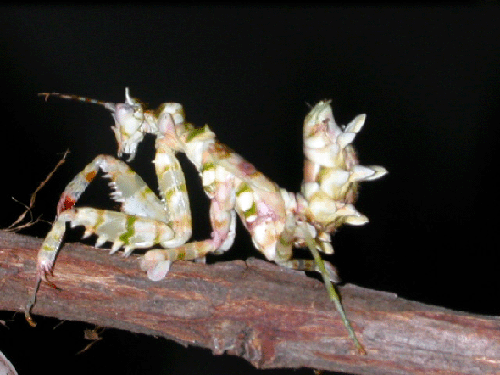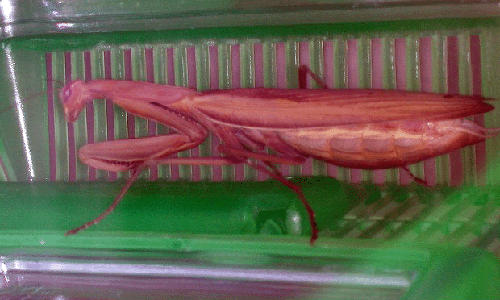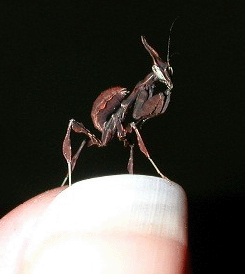



Another Color: Praying Mantids
By Leah Kroo
Citation:
Kroo, L. (2004). Another Color: Praying Mantids. Chameleons! Online E-Zine, August 2004. (http://www.chameleonnews.com/04AugKroo.html)
(Phyllocrania paradoxa adult female)
If you have ever watched the local hubbub of busy insects hovering around a summer evening porchlight, chances are, you have seen one of the insect world’s most fascinating creatures: the praying mantis.
There are more than 2,500 known species that come in all shapes, sizes, and colors ranging from the more typical Carolina Mantis (Stagmomantis Carolina) to the highly exotic Orchid Mantis (Hymenopus coronatus). Most employ camouflage tactics, primarily mimicry, to enhance their survival success. Among the most widely seen mimics are leaves: both dead and live, sticks, bark, grass, flowers, other insects and some being combinations of several, such as the Violin Mantis (Gongylus gongylodes) Ghost mantids (Phyllocrania paradoxa) have even been known to play dead when disturbed.
(Creobroter wahlbergii sub-adult female)
Generally speaking, most mantids are very hardy insects to keep; below you will find care requirements that will suit most mantid species. Keep in mind this is merely a guideline, and research should be done to determine the correct requirements for each species.
Housing:
As with all creatures, the larger the habitat, the better, but a good guide for enclosure space is 3x the adult length and height of the mantid. At least this much space is necessary to promote ample area for the periodic molting of nymphs (immature insects). Aquariums, plastic cages, jars, cups etc. have all been used successfully. The substrate should consist of something easy to clean, and that holds humidity well such as a paper towel, soil, bark, sphagnum moss and other similar mediums. The enclosure should have plenty of sticks and leaves for hiding and climbing, covered with a screen top. Room temp is adequate, around 70 degrees, for most species.
(Parasphendale Affinis adult female and L1 nymph)
Feeding:
There is a lot of variation of opinion on frequency of feeding, some species will gorge themselves and others will not. Generally one or two appropriately sized food items twice a week will be adequate. Care must be used in the number of food items available at any one time, as they can kill the mantid on rare occasions, particularly crickets. Some of the feeding strategies employed by keepers are observance of the abdomen, when it has shrunken, they then feed, or feeding one very large prey item infrequently, or even many very small items daily. None of these has proven particularly better than another, so ultimately, it is the choice of the individual keeper. Nymphs will refuse to eat shortly before a molt, and if this behavior is noticed, remove any food items as they can disturb or kill a vulnerable young mantid..
Prey items can include most any live insect, crickets, moths, caterpillars, worms (such as silk, wax or superworms) spiders, other mantids, grasshoppers etc. Most mantids can be hand fed with a pair of tongs, but they are quite capable of finding and catching prey items on their own. The catching process involves the mantid spotting the prey, turning its head and body towards it, and when the prey gets close, snatching it up with the front claws and devouring it. If it is dropped, the mantid will not retrieve it, waiting for another insect instead. As a breeder, I have noticed a substantial difference in the health and vitality of my nymphs when fed gutloaded prey items. More research into what kinds of things the gutload should contain is needed, however.

(Phyllocrania paradoxa adult female having a bit o’ cricket)
Watering:
Most mantid species will benefit from daily spraying, and moistening the substrate weekly for humidity. Adequate humidity is necessary to promote proper molting. There needn’t be provided a water source, the water that collects on the leaves and sides of the enclosure will be adequate for drinking. Avoid spraying through the screen/mesh top, the mantid will drink from there and chew holes through it.
Behavior:
Generally speaking, most species of mantid are fairly sedentary, preferring to hang under a branch or on a stick most of the day until they are disturbed or see a prey item. When disturbed or provoked, the mantid will sometimes rear up on the hind legs, open the underside of the wings and expose the brightly colored inside of the claws. This defense posture is a means to scare away a predator. The inside of the claws or wings usually have some sort of “eye” pattern. Occasionally they will emit a hissing noise, such as Mantis religiosa.

(Sphodromantis lineola adult female, threat display)
(Mantis religiosa adult female)
General information:
Most species of mantid go through a 7 stage life cycle; each called an instar and referred to as “L”. For example, a newly hatched insect that has never shed is called L1. The frequency of molting varies on environmental factors such as food supply, but as a general rule, the first few molts happen very quickly, every 2-4 weeks for most species. They will double in size and often become more detailed with each shed.(see progression of molt pics below for the Ghost Mantid, (Phyllocrania paradoxa) this species usually only has 6 sheds) After L3 the mantid slows dramatically and molting is infrequent. The 6th stage is referred to as sub-adult and the last, “adult” instead of the “L” designation.
Once adult, the lifespan depends again on environment. Higher temperatures and more food will lend higher metabolism and/or growth rate, but might decrease the lifespan. Alternatively, a mantid kept cool and fed infrequently will fail to thrive.
Most adult mantids will live between 3 and 6 months. Males are on the shorter end and females often exceed 6 months. Females will periodically lay egg cases, called “ootheca,” whether mated or not.
There are so many species of mantid not kept successfully in captivity; more research is needed on captive husbandry, on hundreds of species, from feeding and housing to reproductive techniques. This is a growing field with endless experimentation yet to come. Welcome to the fascinating life of one of the worlds most enchanting predators.

Leah Kroo

Leah Kroo has been working with reptiles since 1996. She started with chameleons and has captive bred over 10 species, and kept many others. Currently, she is working with C. quadricornis. Leah also keeps a wide variety of geckos, primarily Rhacodactylus and Uroplatus species, and is breeding various insects from exotic praying mantids to beetles. You can contact her at sales@wildeyereptiles.com, or www.wildeyereptiles.com.









Join Our Facebook Page for Updates on New Issues:
© 2002-2014 Chameleonnews.com All rights reserved.
Reproduction in whole or part expressly forbidden without permission from the publisher. For permission, please contact the editor at editor@chameleonnews.com













